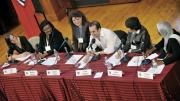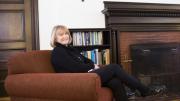Ten years ago, Radcliffe ceased to exist as a college. But reincarnated as the Radcliffe Institute for Advanced Study (RIAS), it has done anything but fade quietly into history. Where some saw the end of an era, those guiding Radcliffe forward saw the potential for a new kind of greatness. Both the trustees of Radcliffe College and those acting on Harvard’s behalf “really did want to create something not just constructive, but imaginative and powerful,” Neil L. Rudenstine, the University’s president at the time of the institute’s creation, recalled at a symposium held October 8 and 9 to mark its tenth birthday.
Those founders wanted “a refuge for scholars” that would also be “an active participant in advancing the University’s intellectual agenda,” the institute’s current dean, Barbara J. Grosz, said at the symposium. Grosz, who is also Higgins professor of natural sciences, joined the institute in 2001 as its first dean of science. (She became dean in 2008, after inaugural dean Drew Faust left for higher office.) In a November interview, Grosz said RIAS had met its major goals for its first decade: establishing an excellent fellowship program that draws scholars from a wide range of fields and advances thinking in culturally current areas such as stem-cell science and new media. The task for the next 10 years, she said, is rounding out the balance of RIAS’s offerings and integrating them more fully within Harvard.
That the fellowship program has blossomed is clear from the list of honors won by past fellows, including at least five Pulitzers, 14 Guggenheims, and one MacArthur. In fact, Harvard Overseer Susan Wallach ’68, J.D. ’71, who was a member of the Radcliffe College Board of Trustees at the time of the merger, noted at the symposium, “It is harder to get a Radcliffe Fellowship than it is to get into Harvard College.” The program—which accepts 6 percent of applicants, compared to the College’s 7 percent—holds such strong appeal, Grosz said, because Radcliffe Fellows “don’t do their work isolated, on their own. They do it as part of a community of scholars, scientists, and artists.”
The program also enriches Harvard’s academic life through fellows’ talks and their participation in academic conferences, among other things. Radcliffe professorships also help the University recruit sought-after scholars with the prospect of spending two years (of their first five as Harvard faculty members) as Radcliffe Fellows.
The institute “plays an especially important role for undergraduates interested in pursuing academic careers” by enabling interaction with scholars from around the world, says Scott Duke Kominers ’09, who regularly attended fellows’ presentations, lectures, and teas at RIAS as an undergraduate—and continues to do so as a first-year student in the business-economics Ph.D. program offered through the Business School and the Graduate School of Arts and Sciences.
The fellows are, thus, not “individuals isolated from the life of the University, ” but “integral to the academic life of Harvard”—precisely what RIAS’s framers envisioned, said symposium speaker Harvey V. Fineberg, who was University provost at the time of the merger. Today, says Grosz, “We need to more fully realize our role as an integral part of the University—one that fosters and enhances the academic work of Harvard faculty.”
To that end, RIAS has launched a suite of Academic Engagement Programs (AEP), with six Harvard faculty members (two each in the arts and humanities, social sciences, and natural sciences) appointed as leaders. For one example, the directors for the social sciences—Aetna professor of public policy and corporate management Brigitte Madrian and Ford professor of the social sciences Robert J. Sampson—are leading a multidisciplinary group of scholars in designing the Boston-based “City as Social Science Laboratory” initiative, which will bring together academics, policymakers, and city leaders for policy and program development in areas such as crime, education, healthcare, and housing.
Meanwhile, without backing away from the heavy emphasis it placed on science programming in its first decade, RIAS is also aiming to bring the social sciences and the humanities to the forefront. Though the fellowship program always included a strong contingent of artists—reflected in a riveting panel on fiction writing and rich presentations of artworks during the anniversary symposium—the AEP leaders are working with their Harvard faculty peers to solicit proposals for themed conferences (open to the public) and seminars (in which scholars from around the world, and often from different disciplines, assemble at RIAS to share their work with each other). The coming year’s offerings include a conference on gender and space in April, and another, on the history and future of the book, in October.
Speakers at the anniversary symposium used archival sources to illuminate not only how people saw Radcliffe—and what its leaders and its students wanted it to be—throughout its history, but also the changing role of women at Harvard. Reading from a Crimson article published her freshman year, journalist and cultural critic Susan Faludi ’81, RF ’09, demonstrated how differently women were seen on campus even then. Chronicling a meeting of the Harvard Dames, a group for graduate students’ wives, the article quoted the club’s president as saying it had been founded “to keep wives off their husbands’ backs during exam time.”
Much has changed, and Radcliffe’s graduates and the College itself were instrumental in those changes. Even as its work cuts across all disciplines, the institute has held onto its Radcliffe heritage through programming on women and gender and by selecting fellows who focus on these issues. Speaking at the symposium via video from Paris, Mary Maples Dunn (the institute’s interim dean in its earliest days, before Faust’s appointment) said, “While men aren’t excluded, women are still at the center.”
In some ways, status as an institute has added to Radcliffe’s value as a resource for those who study women’s issues. As an example, Dunn cited the expanded holdings of the Schlesinger Library on the History of Women in America: during the last decade, increased funding has enabled the library to acquire 23, 400 printed volumes, some 8,700 audiovisual items, and 1,800 manuscripts. The library is also venturing into new media, devising ways to make personal archives in digital formats (e.g., e-mail) accessible to researchers; creating a website that showcases the contents of women’s travel diaries from the library collections; and archiving blogs that feature underrepresented voices and topics.
Supporting scholars and artists; emphasizing interdisciplinary collaboration; working at the leading edge of science; forging ahead into new media: this list of the institute’s top priorities matches closely the priorities of the University as a whole. This echo surely stems in part from the fact that in Faust, both entities have had a common leader. But RIAS, smaller and nimbler, has in some respects leapt ahead of the University. As Fineberg put it: “Harvard has been moving to become more like Radcliffe.”









